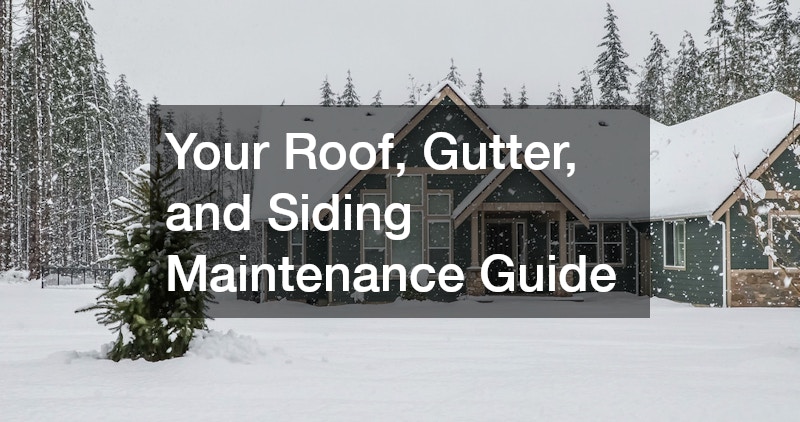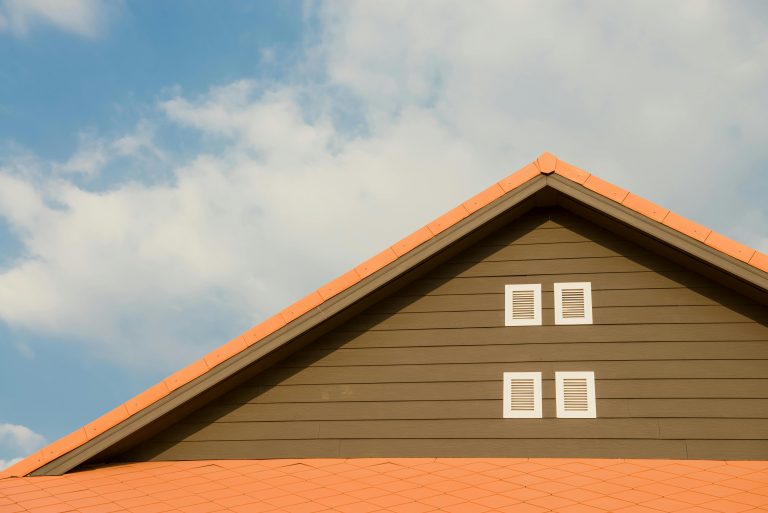

Your home’s roof, gutters, and siding are crucial to its structural integrity and aesthetic value. These components form a protective barrier against the elements, helping to maintain a comfortable indoor environment while preventing water intrusion, pest infestations, and long-term decay. Over time, however, exposure to weather and natural wear can take a toll. That’s why regular maintenance isn’t just recommended—it’s essential. By staying proactive with inspections, cleaning, and timely repairs, you can avoid expensive problems and extend the lifespan of your exterior features. Whether you’re managing routine upkeep or planning larger projects with roofing contractors or a local siding contractor, this guide will provide you with a comprehensive roadmap to home exterior maintenance.
How Often Should You Clean Your Gutters and Siding?

Recommendations for Gutter Cleaning Frequency
Gutters are often out of sight and, unfortunately, out of mind—until a problem arises. To prevent water from backing up and damaging your roof or foundation, you should clean your gutters at least twice per year, ideally in the spring and fall. Homes with heavy tree coverage may need quarterly cleanings to remove leaves and twigs that could cause blockages. Keeping your gutters clean also supports the health of your roofing system and helps reduce future roof repair costs by minimizing moisture damage.
Optimal Times for Siding Maintenance
Your siding faces constant exposure to sun, rain, and wind, making routine cleaning a priority. Most experts recommend washing your siding once a year to prevent the buildup of grime, mold, and algae. If your home is near the coast, a desert, or experiences high humidity, you may want to clean your siding more frequently. Scheduling cleanings in spring or early summer allows you to assess whether siding repairs or even full siding replacement might be necessary before the harsher seasons arrive.
Signs It’s Time for a Cleaning
If you notice discoloration, streaking, mildew, or greenish tints on your siding or gutters, these are visual cues that it’s time for a cleaning. Sagging gutters or ones that overflow during a light rain can indicate blockages. Likewise, peeling paint, warping panels, or visible cracking may indicate underlying issues that warrant the expertise of a fiber cement siding company or a siding replacement specialist.
Seasonal Considerations
Each season brings unique challenges to your home’s exterior. Spring may reveal winter damage, while fall fills gutters with leaves. Summer heat can dry out sealants and cause expansion in materials like vinyl or metal, making inspections vital. Winter brings the risk of ice dams and snow loads that stress your gutters and roofing. Seasonal care helps detect issues early and enables timely consultation with roofing contractors or local siding professionals.
Professional vs. DIY Cleaning
Homeowners comfortable with ladders and basic tools can manage cleaning tasks themselves, but professional services offer thorough inspections and safe execution. Hiring a local siding contractor or a roofing specialist ensures that no issue goes unnoticed and that specialized surfaces like fiber cement or corrugated roofing are properly treated without damage.
What Tools and Materials Are Needed for Gutter and Siding Maintenance?
Essential Tools for Gutter Cleaning
To clean gutters effectively, you’ll need a stable ladder, work gloves, a scoop or small garden trowel, and a bucket or tarp for debris collection. A hose with a spray nozzle helps flush out remaining particles and test the downspout flow. For homes with complex rooflines or tall elevations, consider professional help to avoid injury.
Effective Siding Cleaning Supplies
For siding, a soft-bristle brush and a garden hose usually suffice for routine cleaning. Tougher stains may require a siding-safe detergent or a diluted vinegar solution. Power washers can be used cautiously, particularly on hardier materials like fiber cement or metal, but they should be avoided on delicate siding to prevent water intrusion and damage.
Safety Equipment for Roofing Tasks
When inspecting or cleaning around the roof, wear non-slip shoes, gloves, and a safety harness. Roofing contractors typically use personal protective equipment such as helmets and fall arrest systems, which significantly reduce the risk of accidents during maintenance or roof repair activities.
Eco-friendly Cleaning Products
Biodegradable cleaners are available for both gutters and siding. These products minimize environmental impact and reduce the risk of harming nearby plants or polluting runoff systems. They’re especially useful in areas with strict environmental regulations or when working around gardens and landscaping.
Storage and Care of Maintenance Equipment
Store tools in a dry, clean space to prevent rust and corrosion. Garden hoses and soft brushes should be drained and hung properly after use. Keeping your equipment in good condition saves time and money and ensures effective maintenance throughout the year.
What Are the Common Problems with Gutters and Siding?

Identifying Gutter Blockages and Leaks
One of the most common gutter issues is clogging from debris, which can lead to overflow and water damage. Leaks often occur at seams or downspouts due to loosened connectors or worn-out sealant. Unaddressed, these issues can impact your home’s foundation and even cause rot in fascia boards and roofing materials.
Detecting Siding Damage and Wear
Warped, cracked, or faded siding not only affects curb appeal but may also allow moisture intrusion. If you notice signs of bubbling paint or dark stains, you might need more than cleaning—you may need siding repairs or a full replacement, particularly if your siding is aged or improperly installed.
Recognizing Roof Issues Linked to Gutter Problems
Clogged or damaged gutters can direct water under shingles or flashing, leading to roof leaks. Over time, this water intrusion can result in mold growth, insulation damage, and structural weakening. Routine gutter care complements roof maintenance, and roof repair may be necessary to correct water-related issues before they spread.
Understanding Water Damage and Mildew
Unchecked water runoff from clogged gutters or cracked siding can lead to mildew, mold, and rot on your home’s exterior and interior. Fiber cement siding, while moisture-resistant, can still suffer from improper installation or surrounding gutter leaks. Prompt attention can prevent costly siding replacement or remediation.
When to Seek Professional Help for Repairs
If you’re unsure of the extent of the damage, consult a professional. A fiber cement siding company or a metal roofing company can perform a comprehensive assessment. Their knowledge ensures precise fixes and helps you avoid misdiagnoses that can lead to wasted time and resources.
How to Inspect Your Roof, Gutters, and Siding for Damage
Steps for a Roof Inspection
Begin your inspection from the ground using binoculars. Look for missing or curling shingles, rusted flashing, and discoloration. TPO roofing systems, commonly used on flat or low-slope roofs, should be inspected for seam separation or punctures. Any unusual sagging or pooling water indicates urgent roof repair is needed.
Checking Gutters for Clogs and Cracks
Inspect gutters during or after rainfall to observe water flow. Look for signs of sagging, overflowing, or water marks on your siding, which suggest blockages or leaks. Cracks or corrosion in metal gutters should be repaired quickly to prevent surrounding material damage.
Assessing Siding for Signs of Wear
Look closely at seams, joints, and bottom edges where moisture tends to collect. Inspect for insect damage, cracking, or loosening panels. Fiber cement and corrugated siding are more resilient, but even these require occasional attention to remain effective.
Using Technology for Inspections
Drones and infrared scanners can provide detailed images of hard-to-reach areas and detect hidden moisture or insulation issues. These tools are increasingly used by modern roofing contractors and siding professionals to provide accurate assessments.
Documenting Inspection Results
Take photos and keep notes during each inspection. Tracking issues over time helps you anticipate when siding replacement or roof repairs may be necessary. It also provides useful records when hiring a roofing contractor or filing a warranty claim.
How to Repair Common Gutter and Siding Issues
Fixing Leaky Gutters
Apply gutter sealant to cracks and use rivets or brackets to secure loose sections. For large holes or heavily corroded spots, consider replacing affected segments. Metal gutter systems, especially those installed by a metal roofing company, can last decades with proper care.
Replacing Damaged Siding Panels
Cracked or warped siding should be removed and replaced with matching material. A fiber cement siding company can help source high-quality replacements that blend seamlessly. Matching the existing color and style ensures your home maintains its visual harmony.
Patching Small Roof Leaks
Leaks often originate from around flashing or in valleys where shingles meet. Roofing cement and sealant tapes offer temporary fixes, but persistent problems may require attention from certified roofing contractors, especially for more complex materials like TPO or corrugated roofing.
Handling Mould and Mildew on Siding
Use a mixture of water and white vinegar or a siding-specific cleaner to scrub away mildew. Avoid pressure washers on fragile siding as they can cause damage. If the issue returns frequently, check your gutters and roof for leaks that may be contributing to moisture buildup.
Tools and Supplies for DIY Repairs
Basic repairs typically require a caulking gun, sealant, replacement panels, and fasteners. For safety, always use appropriate ladders and wear protective gear. For larger or high-risk tasks, it’s better to call a professional than risk injury or further damage.
What Are the Benefits of Regular Roof, Gutter, and Siding Maintenance?

Enhancing Home Curb Appeal
Clean, well-maintained exteriors boost your home’s appearance and perceived value. This is especially important if you plan to sell. Freshly repaired or upgraded elements—like clean gutters, new siding panels, or updated metal roofing—create a strong first impression.
Preventing Structural Damage
Water damage and pest infestations can compromise framing, insulation, and even foundation integrity. Keeping up with regular gutter and siding maintenance stops these issues before they require major reconstruction.
Increasing Energy Efficiency
Tight seams, solid siding, and well-maintained roofing reduce heat loss and drafts. TPO roofing and fiber cement siding offer excellent thermal performance when maintained, helping lower heating and cooling costs.
Extending Roof and Siding Lifespan
Routine maintenance adds years to the life of your roof and siding. Small tasks like sealing cracks, cleaning debris, and applying protective coatings reduce the likelihood of major damage, minimizing roof repair cost over time.
Cost Savings Over Time
Though maintenance requires an initial time or financial investment, it significantly lowers your long-term costs by preventing emergency repairs, premature replacements, and energy inefficiency.
How to Choose the Right Materials for Your Gutters and Siding?
Comparing Different Gutter Materials
Aluminum, vinyl, steel, and copper all have their advantages. Aluminum is lightweight and rust-resistant, while copper offers unmatched durability. Metal roofing companies often recommend coordinating gutter systems with your roof material for optimal performance and visual consistency.
Selecting Durable Siding Options
Popular options include vinyl, wood, engineered wood, and fiber cement. Fiber cement siding is known for its resistance to rot, fire, and pests, making it a top choice among homeowners seeking longevity with low maintenance needs.
Understanding Material Longevity
Corrugated roofing can last up to 50 years when properly maintained. Similarly, fiber cement siding can last decades without warping or fading. Understanding these timelines helps you weigh initial investments against long-term performance.
Considering Climate Impact on Material Choice
In humid climates, materials that resist mold and mildew are essential. In areas with high winds or hail, impact-resistant siding and roofing materials like metal or fiber cement are ideal. A local siding contractor can help assess your home’s unique needs based on local conditions.
Investment vs. Budget Considerations
Balancing upfront cost with expected lifespan is key. While premium materials cost more initially, they often require fewer repairs and replacements. Consulting with a roofing contractor or fiber cement siding company can help clarify the best long-term value for your budget.
What Are the Best Practices for Gutter and Siding Installation?
Steps in the Installation Process
A thorough inspection of your existing structure is followed by careful removal of old materials. Flashing, underlayment, and weatherproof barriers are installed before new gutters or siding are attached. Proper slope, alignment, and secure fastening are crucial for functionality.
Choosing a Reputable Installer
Look for licensed and insured professionals with experience in your desired material. Check online reviews, ask for referrals, and ensure they offer warranties on their work. A well-reviewed local siding contractor or roofing contractor will deliver reliable results and peace of mind.
Understanding Warranties and Guarantees
Many manufacturers offer 20–50 year warranties on roofing and siding products. Confirm what’s covered and ensure the installer honors those terms. Workmanship guarantees further protect your investment.
Common Mistakes During Installation
Improper flashing, poor alignment, and insufficient fasteners can lead to future issues. Installers unfamiliar with materials like TPO roofing or corrugated siding may cut corners. Hire specialists for complex materials to ensure longevity and proper performance.
Long-Term Maintenance Tips Post-Installation
Schedule inspections and cleanings at least annually. Use manufacturer-recommended products and avoid harsh chemicals. Monitor seams and joints regularly to catch early signs of wear or moisture infiltration.
What Are the Seasonal Challenges in Roof, Gutter, and Siding Maintenance?
Winter: Ice Dams and Snow Loads
Heavy snow and ice can damage gutters and roofing systems. Ice dams may force water under shingles, leading to leaks. Use roof rakes and ensure proper attic ventilation to reduce buildup.
Spring: Heavy Rains and Overflowing Gutters
Spring rains can quickly reveal clogs and leaks. Make gutter cleaning and inspection a priority during this season to prevent water damage.
Summer: Heat Impacts on Materials
UV exposure can degrade materials, especially lower-quality siding and roofing. Inspect for warping, cracking, or faded colors, particularly on sun-exposed sides of your home.
Fall: Leaf Buildup and Debris Clearing
Autumn is prime time for gutter clogs. Remove leaves and debris promptly and inspect siding for moisture intrusion caused by decaying organic matter.
Preparing for Extreme Weather Events
Storm prep includes clearing gutters, securing loose siding panels, and inspecting flashing. Reinforcing vulnerable areas protects your home during hurricanes, blizzards, or high winds.
How to Maintain Gutters and Siding in Different Climates?

Coastal Regions: Salt and Humidity
Salt can corrode metal and create staining on siding. Use corrosion-resistant materials and rinse exterior surfaces regularly to extend longevity.
Desert Areas: Heat and Sand
High temperatures can warp or crack traditional siding. Choose materials like fiber cement that withstand UV rays and resist sand abrasion.
Cold Climates: Ice and Snow Management
Fiber cement and metal roofing perform well in freeze-thaw cycles. Regular snow removal and roof inspections prevent long-term damage.
Tropical Zones: Rain and Pest Concerns
Heavy rainfall and humidity create ideal conditions for mold and insects. Use moisture-resistant materials and inspect frequently for pest activity.
Adapting Maintenance Intervals and Techniques
Climates with extreme conditions require more frequent inspections and specialized materials. Consult local experts to tailor your approach accordingly.
Routine maintenance of your roof, gutters, and siding is not just about appearance—it’s a crucial step toward protecting your home’s value and functionality. Whether you’re working with roofing contractors for a major roof repair or hiring a local siding contractor for siding replacement, staying proactive will save you time and money in the long run. With the right tools, materials, and knowledge, you can ensure your home’s exterior remains strong, efficient, and beautiful for years to come.
https://www.CandKroofingID.com/roofing-products
https://www.CandKroofingID.com/roofing-products
https://www.CandKroofingID.com/roofing-products
https://www.CandKroofingID.com/roofing-products
https://www.CandKroofingID.com/roofing-products
https://www.CandKroofingID.com/roofing-products
https://www.CandKroofingID.com/roofing-products
https://www.CandKroofingID.com/roofing-products




